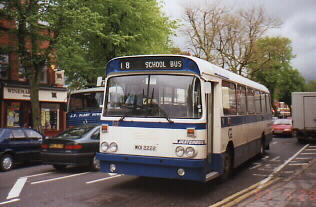
Ordinary round bus, Newcastle/Ballynahinch 222, seen here in Stranmillis in Belfast in April 1997
| Ulsterbus Page |
| General Information | Fleet List | Vehicle Types | Services | Downpatrick Fleet |
I am far from being an expert on the Ulsterbus fleet, but I will try and describe it all here to the best of my knowledge. Some information has been helpfully contributed by Mark McAleer and Paul Haughey.
I suppose Leyland Leopard buses must have been a 'constant' in the Ulsterbus fleet, from the late 1960s right up to today and into the future. There have been over 600 altogether, with over 200 in service today. Nearly all of them have Alexander (Belfast) bodies.The first Leyland Tiger, 340, went into service in January 1984, with the last Leopard, 339, entering service in March 1984 (I think). These buses now live in Newcastle and Oxford Street respectively. Leyland Leopards are by far my favourite type of bus and I still think of them as 'Round Buses'-- what I called them before I knew their proper name. This name comes from the shape of their body around the destination screen. The newer Leyland Tigers are called square buses for the same reason.

Ordinary round bus, Newcastle/Ballynahinch 222, seen here in Stranmillis
in Belfast in April 1997
I was always interested in the 'Pneumocyclic' gearlever / gearbox in round buses, and really like the noise their engines make make better than any other buses' noises. (It might partly be because they are noisier than newer buses.) Here is a recording of a Leyland Leopard bus, Lisburn-based 139, which I recorded late last year. All the buses from about NOI onwards (1977 approx.) have 5 forward gears. The first one is only used for starting on steep hills. When I was just starting school we used to get KOI- registered Leopards all the time (1962 or 1960) and they had just 4 forward gears (I'm nearly sure, but it's hard to imagine it now). The buses from about ROI onwards have an emergency exit window half way up and just one door at the back. (Older buses had two emergency exit doors at the back.) Alternate batches of the buses have 49 soft seats and 53 hard seats. The soft-seated ones are much nicer inside and have wooden veneer instead of stainless steel panelling.
The numbers of Leopard buses now are falling, although they have hardly depleted at all for a few years and lots of buses are approaching 20 years old. Ulsterbus fares recently (March 1998) went up by the biggest amount I can ever remember, so maybe all the extra money's going to be used to buy new buses. The oldest buses in service are from 1978 (I think there is still one Bristol RE [which I will come to later] from 1977 in service in Newtownabbey), but that doesn't include tow buses. Several much older buses are still in service as these, including 1902 (HOI 1902) from 1975 in Derry, shown below.
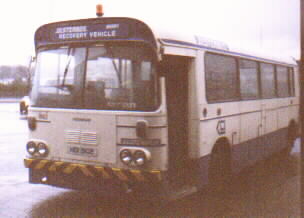
Leyland Leopard / Alexander 1902, a tow bus based in Derry seen here
in Foyle Street Bus Station in the city
Other old Leopard tow buses I know of and have seen are 9512 (DOI 1512) from 1972 which has recently moved to Newtownards from Newtownabbey, 1983 (NOI 1983) from 1977 in Great Victoria Street, Belfast (shown below) and 111 (TBZ 8399 ex-ROI 111) from 1978 in Downpatrick. There are one or two older buses than 111 still in service in places like Armagh however, so it isn't very exciting to see. Most of the tow buses have their rear overhang chopped off and are painted with yellow and black stripes on the front or back or both, so look very distinctive.
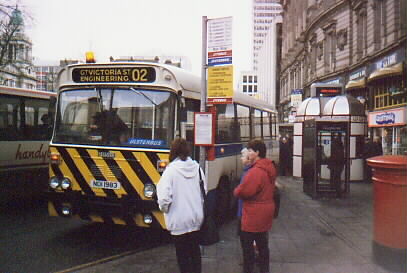
Ulsterbus Leopard tow bus 1983, seen here attending to a broken-down
Citybus in Belfast city centre. A Citybus handybus is on the left below part of
the City Hall, while the Citybus ordinary and Sunday (yellow) bus stops can be
seen in the centre. The Citybus ticket kiosk is behind the phone boxes on the
right
One or two old Leopard buses are being refurbished: the one I'm familiar with is Oxford Street's 248 (WOI 2248), although I've never been on it. It was fitted with 3 + 2 seating in June 1997, and probably was refurbished in other ways as well but the seating is the only new thing visible when I see it driving down Malone Road in Belfast on a school bus route in the afternoons. This refurbishment will help to prolong the buses' lives, and of course I think it's a very good idea, because I like these buses so much.
Ulsterbus bought its first Leyland Leopards in 1969. The first one was 1301 (4001 WZ). Ulsterbus had still kept it until maybe less than a year ago in the hope of preserving it, but apparently it had rotted away so much that they just sold it for scrap. It would have been withdrawn from service round about 1985. According to the records a sister of this bus, 1307 (4007 WZ), is still in service with Lough Swilly in Fanad, Donegal registered 69-DL-18. It would be nice to rescue it and preserve it. I wouldn't know very much about how to go about that, but I would probably buy the bus if somebody offered it to me.
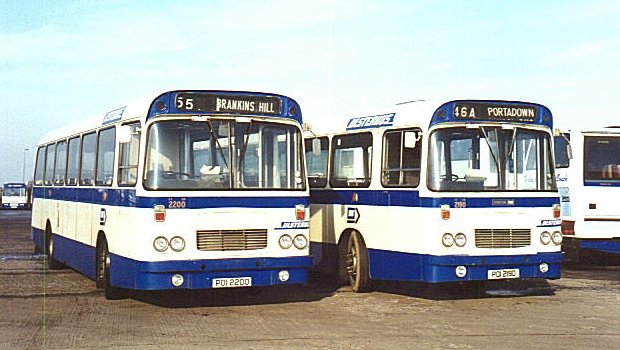
Two of Ulsterbus's POI- registered Bristol REs, 2200 and 2190, are seen
here parked in the sunshine somewhere around Craigavon. 2200 is now scrapped,
but I think 2190 may be still around in Newtownabbey, although it wouldn't be
working now over the summer. Photograph supplied by Paul Haughey
At the same time as the first Leyland Leopards were bought, Ulsterbus bought the first Bristol REs. I would guess that these were meant mainly for service in places like Derry City. I don't really know very much at all about the early batches. In 1975, however, Ulsterbus started buying Bristol REs for itself and Citybus which it had taken over; these were numbered in the series 2003 to 2600. If Citybus kept its Bristol REs as long as some bus companies in England seem to have, they would probably still make up the whole fleet, but as it happens it is disposing of them rapidly, selling some for scrap when they are barely 17 years old. Ulsterbus has kept its REs much longer, and as I mentioned before, I think the oldest bus still in service with Ulsterbus is an RE from late 1977, 2190 (POI 2190), based in Newtownabbey.
The buses have quite shallow steps at the front and inside there is a noticeable slope up to the back. They have only a manual handbrake (air brake on Leopards), which looks very old-fashioned, and don't have power steering (although the relatively light steering means the steering wheel doesn't need to be too big). The grille over the radiator at the front makes it easy to distinguish these buses from Leopards at a distance, even though their bodies have the same shape. They are different at the back as well, having their emergency exit door at the end of the aisle with a double seat on either side of it. (Leopards have a long 5-seater back seat with an emergency door at both ends or one end of it, depending on how old the bus is.) The REs have an interesting gear lever attached to the steering column, which I think works via electric relays. On Citybuses one of the gear positions (it seems to vary between top left and bottom left depending on the bus) is for opening the door, but all the Ulsterbus REs I've been on have a pedal for opening the door, so I don't know what the extra gear postion is used for on these. The buses make a high-pitched whine noise which I think comes from the gearbox. It's very interesting (I think) in that it doesn't really change to a lower pitch when changing up a gear; the pitch continues to rise and never really seems to stop, getting higher the faster the bus goes. I've only got to know Bristol REs since coming to Belfast as a student in 1996, and haven't really had a chance to get very attached to them; I much prefer Leopards.
For as long as I can remember there have never been any Bristol REs permanently based in Downpatrick, and they seem to be essentially 'city' buses and so would mostly be used in big towns and urban locations; for example there are a lot in Craigavon depot (Craigavon is really a conurbation of the two towns Lurgan and Portadown), and the photograph above shows an RE which has been working a journey between Lurgan and Portadown-- a mainly urban route. Newtownards depot, which I would say is a country town even though it's quite near Belfast, has a proportionally large amount of Bristol REs in its fleet, and these are used on many rural services and on the Belfast - Newtownards route. As I suppose the REs are meant for working in cities they don't seem to be able to go very fast, but part of the route from Belfast to Newtownards (via New Road) is on a dual carriageway. I was on 2436 (WOI 2436) on this route recently and the bus really struggled to keep up the speed until it was going downhill. Even then I don't think it went much faster than 50 mph, but the 'whine' coming from the gearbox seemed to get so high pitched you could hardly hear it (although maybe it just dies away at high speeds).
I think the RE stands for 'rear engine'; having the engine at the back means the front can be lower with less steep steps, making the bus better for work in cities where people are getting on and off a lot. (Leopards have underfloor engines and have two steep steps just inside the door.) The full model name for all the REs Ulsterbus bought new is Bristol RELL, the LL standing for something like 'long vehicle with a low floor'. In the mid-1980s there were some second-hand Bristol RESL buses around, which means 'short vehicle with a low floor'. RESLs don't have as many seats on them as RELLs.
In 1974 Ulsterbus bought some Bristol LH buses, which are a type of RE with LH standing for 'long vehicle with a high floor'. The last of these to be withdrawn was 1629 which lived in Downpatrick until 1988. I don't remember it since I only started travelling on Ulsterbuses in 1989. Below is a photograph of the old 1629. (There is a new 1629 which is a Goldliner Mk. IV, and on which I quite regularly travel between Downpatrick and Belfast.)
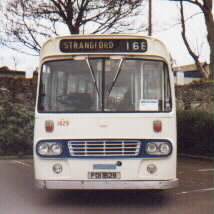
Bristol LH 1629 seen here pretending to be going from Downpatrick
to Strangford at the Irish Transport Trust's Annual Bus and Coach Rally in
Bangor
There are also two second-hand Bristol LHs which I think might have been used on the University Link service 163 in Belfast when it was only starting a few years ago.
For completeness, other types of Bristol RE were the SH (short high floor) and MH (another high floor, 12m long coach version). Not as many of these were built and I don't think there were ever any examples in the Ulsterbus fleet.
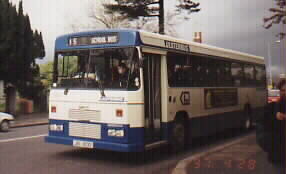
Leyland Tiger / Alexander 1033 based in Downpatrick, seen here on Malone
Road in Belfast runnning a school bus service, while temporarily outstationed
at Saintfield depot
Coming much more up-to-date, I can easily remember when new Leyland Tigers were still coming into service. They are used in the place of both Leyland Leopards and Bristol REs (i.e. for towns and cities and rural journies). They have an underfloor engine but the buses from IXI onwards have much shallower steps at the front, though I think slightly steeper than on an RE. Models from the first DXIs up to HXI all have steep Round bus-style steps.
The Tigers in the Ulsterbus fleet have two engine types and two body types, but they overlap a bit. Up to fleet number 1299 (end of OXI) the buses have 'square bus' bodies-- Alexander N-type and Leyland engines with semi-automatic gears. On some of the newer Leyland-engined Tigers when changing gears there is a short automatic delay before the next gear is engaged: this is to avoid damage to the gearbox by bus drivers who do not pause in neutral when changing gear. This feature isn't included in the pneumocyclic semi-automatic gearboxes on Leopards. On Tigers the gear lever is on the driver's right hand side, and there is power steering (REs are the only buses not to have power steering). Tigers make quite nice engine noises as well: here is a recording of 1033 (JXI 1033) I made when I was doing the sound effects for our school show in 1992.
From fleet number 1300 to 1339 all the buses except 1321 (RXI 3321) have old N-type (square bus) bodies but new Volvo engines with automatic gears. They don't really make as nice a noise as the older engines, and are a bit quieter. All the rest of the buses from 1340 (TXI 1340) to 1500 (YXI 5500-- the last Leyland Tiger ever built) have new Cityliner bodies as shown on 1500 in the photograph below, except Goldliners Mk. III 1408--1432 which have Wright coach bodies. 1340--1359 are also Goldliners (Mk. II) but still have Alexander Cityliner (Q-type) bodies.

Leyland Tiger / Alexander Cityliner 1500, seen here
resting in Market Square in its home town of Lisburn, one morning in June
1998.
Not fitting into the ordinary bus numbering range are the Mk. I Goldliners from 1990, 514 to 529. They have funny-looking Alexander TE-type bodies and have Leyland engines but automatic gearboxes. The automatic gears always start in first gear while bus drivers start in second, so the noises made by these old Goldliners are quite interesting.
There are some other Leyland Tigers used as coaches, which I might mention later. They have mainly Duple or Wright bodies and have manual gears.
These are the newest standard Ulsterbus, or current 'mainstay of the vehicle replacement programme', as Ulsterbus might put it. 100 were delivered during 1994 and 30 more arrived in 1996. The first 50, 1501 to 1550, had Alexander Q-Type Cityliner bodies and 3 + 2 seating for most of the length of the bus and all had DAZ numbers. A photograph of one of this type, Newcastle / Ballynahinch based 1548, is shown below.
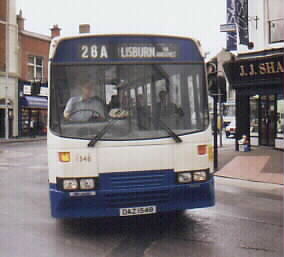
Volvo B10M / Alexander 1548 is seen here arriving in Lisburn
from Ballynahinch
These buses have automatic gears and as would be expected, sound quite similar to the Volvo-engined Tigers, but have some other distinctive noises of their own and I think I could get to like them well over time. The backs of the uncomfortable 'individually sculpted' seats in the first few rows are made of plastic and appear to be very hard to clean, as there always seems to be some partially rubbed-off grafitti on them on most of the Volvo / Alexander buses I've been on. The seats further back are much more comfortable and nice.
Bus B10Ms have a panel on the door into the driver's cabin displaying the message 'ULSTERBUS- Welcome Aboard. Save Time - Tender Correct Fare' or something like that, which is quite nice, although the typestyle of the Ulsterbus logo is out of date now.
The next fifty were the first of the Mk. IV Goldliners and have Plaxton Premiere coach bodies. They look really impressive and are very nice, but I find there isn't enough leg-room if the person in front has reclined their seat. The other problem with them is that the door doesn't open until the handbrake is on, and the bus driver can't put the handbrake on until the bus is stationary and even then the door still takes a few seconds to open so a bit of time is wasted at every stop waiting for the door to open.
The thirty newest ordinary buses in the Ulsterbus fleet are 1601 to 1630 with JAZ numbers, and are very similar to the other Mk. IV Goldliners except their destination blinds are easier to see, with a bigger 'aperture' at the top of the window and also the blind itself being closer to the window, so there aren't any problems with condensation on the inside of the destination window, as I have noticed on earlier Mk. IV Goldliners.
There are a few Volvo B10Ms in the coaching fleet in Glengall Street, including one from 1987 600 (KXI 600), which Ulsterbus maybe bought because they wanted a short coach and there was a short version of the B10M. It had a Plaxton body, but the two newer short coaches, 511 and 512, have Portuguese (I think) Caetano bodies, as shown on 512 in the photograph below. These short coaches seem to be very much in demand for small tours and private hires and I have even seen one being used for driver training- maybe the short length and automatic gears make it easier for somebody just learning to drive a bus.

Volvo B10M / Caetano coach 512 (JAZ 5512), based in Glengall Street in Belfast,
seen here in Interlaken in Switzerland.
This is a low floor bus with a very similar name to the B10M, but it looks completely different. Ulsterbus bought 10 B10Ls to use on Derry city services early in 1997, one of which is seen in its home city in the photograph below. Citybus have 51 B10Ls, 2700-2750 and 2761 (2736 was maliciously destroyed in Summer 1997) and Ulsterbus's 10 are numbered 2751-2760.
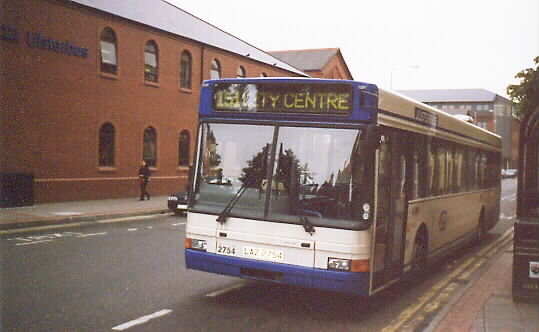
Volvo B10L / Alexander 2754, seen resting here in Foyle Street, Derry (across the
road from the bus station) on a warm Summer's evening in June 1997
The B10Ls are really rather noisy for new buses, and it's nice sitting at the back of them on top of the engine listening to the noise. They have automatic gears of course, and an electronic destination display composed of lots of tiny squares black on one side and fluorescent yellow on the other. They have nice really wide doors and plenty of stop buttons, encouraging people to press them instead of just walking up to the front and waiting for the driver to stop.
The photograph below of some buses in Newry depot in June 1997 shows two of the types mentioned previously. (It's a bit dark because the sun was in the wrong place when I was taking it.) Furtherest to the right is a Bristol RE, 2291 (TOI 2291) which was in service with Citybus up to 1993, and in between two Leyland Tiger Mk. II Goldliners with Alexander Cityliner bodies is a Bus Eireann GAC rural bus. (Bus Eireann run local services between Dundalk and Newry.) You can read more about Bus Eireann buses at the Irish Bus Site.
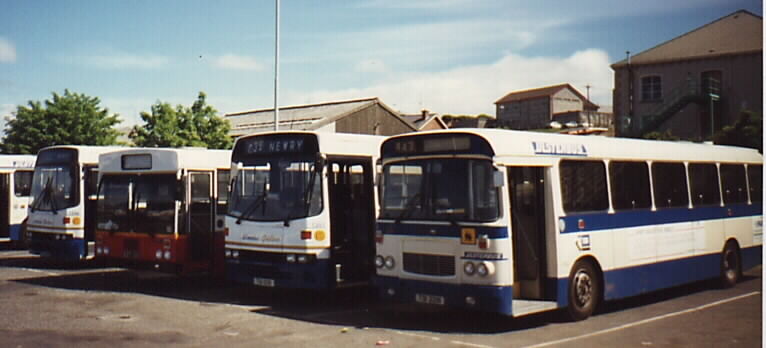
Some buses pictured in Newry depot
More vehicle types including Busybuses (Mercedes) and Handybuses (Dennis Dart) will be added in the future
Northern Ireland Bus Site |
| Index | Ulsterbus Page | Citybus Page | Lough Swilly Page | Links |